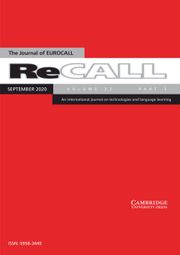Crossref Citations
This article has been cited by the following publications. This list is generated based on data provided by
Crossref.
Mamun, Shamsul Arifeen Khan
Danaher, P. A.
and
Rahman, Mohammad Mafizur
2015.
Handbook of Research on Advancing Critical Thinking in Higher Education.
p.
142.
Zhu, Sha
Qiu, Hongjing
Yang, Harrison Hao
and
Zhang, Yi
2016.
Blended Learning: Aligning Theory with Practices.
Vol. 9757,
Issue. ,
p.
258.
Al-Shehri, Saleh
2016.
Handbook of Research on Human Social Interaction in the Age of Mobile Devices.
p.
22.
Porter, Wendy W.
Graham, Charles R.
Bodily, Robert G.
and
Sandberg, Daniel S.
2016.
A qualitative analysis of institutional drivers and barriers to blended learning adoption in higher education.
The Internet and Higher Education,
Vol. 28,
Issue. ,
p.
17.
王, 伟
2016.
Brief Analysis of Teaching Ways of Chinese Idioms in Teaching Chinese as a Foreign Language.
Modern Linguistics,
Vol. 04,
Issue. 01,
p.
1.
Chang, Jia-Wei
Lee, Ming-Che
Su, Chien-Yuan
and
Wang, Tzone-I
2017.
Effects of using self-explanation on a web-based Chinese sentence-learning system.
Computer Assisted Language Learning,
Vol. 30,
Issue. 1-2,
p.
44.
Liu, Haixia
Lin, Chin-Hsi
and
Zhang, Dongbo
2017.
Pedagogical beliefs and attitudes toward information and communication technology: a survey of teachers of English as a foreign language in China.
Computer Assisted Language Learning,
Vol. 30,
Issue. 8,
p.
745.
Du, Xiangyun
Zhao, Ke
Ruan, Youjin
Wang, Li
and
Duan, Xiaoju
2017.
Beginner CFL learners’ perceptions of language difficulty in a task-based teaching and learning (TBTL) environment in Denmark.
System,
Vol. 69,
Issue. ,
p.
108.
2017.
Shayo, Eva
Mwase, Christine
and
Kissaka, Mussa
2017.
Barriers towards the adoption of a practical training management system at the University of Dar es Salaam.
p.
1.
Mamun, Shamsul Arifeen Khan
Danaher, P. A.
and
Rahman, Mohammad Mafizur
2017.
Blended Learning.
p.
1565.
Al-Shehri, Saleh
2017.
Blended Learning.
p.
713.
Maia, Ana
Borges, Jorge
Reis, Arsénio
Martins, Paulo
and
Barroso, João
2018.
Research on e-Learning and ICT in Education.
p.
153.
Basri, Wael Sh.
Alandejani, Jehan A.
and
Almadani, Feras M.
2018.
ICT Adoption Impact on Students’ Academic Performance: Evidence from Saudi Universities.
Education Research International,
Vol. 2018,
Issue. ,
p.
1.
Huang, Ting
and
Lammers, Jayne C.
2018.
A qualitative inquiry of video learning by Chinese L2 learners.
Chinese as a Second Language (漢語教學研究—美國中文教師學會學報). The journal of the Chinese Language Teachers Association, USA,
Vol. 53,
Issue. 3,
p.
257.
Previtali, Pietro
and
Scarozza, Danila
2019.
Organizing for Digital Innovation.
Vol. 27,
Issue. ,
p.
199.
Soulé, María Victoria
and
Papadima-Sophocleous, Salomi
2019.
Professional development in CALL: a selection of papers.
p.
25.
Nascimiento, María Manuel
Nunes, Paula Sofía
and
Catarino, Puala
2020.
Fatores que Influenciam o Uso de Software Educativo no Ensino de Matemática.
REICE. Revista Iberoamericana sobre Calidad, Eficacia y Cambio en Educación,
Vol. 18,
Issue. 3,
p.
113.
RAJEEV, KUMAR
and
POONAM
2020.
AWARENESS AND USE OF ICT AMONG GOVERNMENT COLLEGE STUDENTS IN HIMACHAL PRADESH.
i-manager's Journal of Educational Technology,
Vol. 16,
Issue. 4,
p.
33.
Rudhumbu, Norman
Parawira, Wilson
Bhukuvhani, Crispen
Nezandoyi, Jacob
Majoni, Cuthbert
Chikosha, Felix
Zvokuomba, Kwashirai
and
Chingwanangwana, Bernard
2021.
Insight into online teaching behaviour of lecturers in Zimbabwean universities during the COVID-19 era and beyond: issues and challenges.
The International Journal of Information and Learning Technology,
Vol. 38,
Issue. 5,
p.
518.

